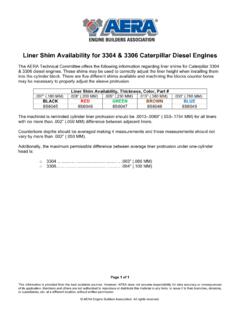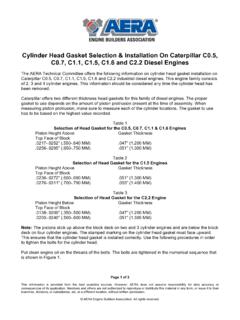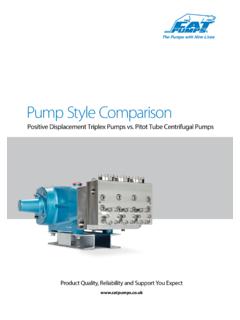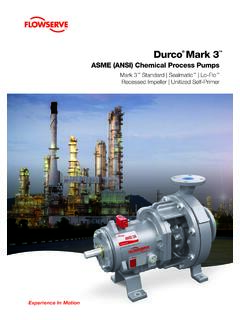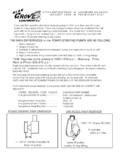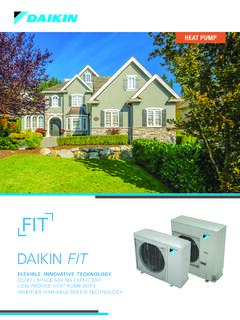Transcription of Proper PCV Valve Selection for a High Performance Engine Build
1 34 JULY-SEPT 2015 Engine professionalIt isn t uncommon to see 50 or more PCV valves on the shelf of any auto parts store. Each one has unique flow characteristics and vacuum transition points, and is designed to work with the vacuum and blowby requirements of a certain group of engines. Knowing which Valve to pick for a modified Engine Build is difficult to impossible, and usually involves a lot of guess work. Making matters worse, PCV Valve manufacturers and OEMs are reluctant to share any PCV flow data. Without this information, the consumer s only option is to purely guess at which valves have which flow further complicate matters, Performance Engine builds very seldom retain all stock components.
2 So even if your vehicle s PCV Valve has a listing in the parts book, if the cam, heads, intake or any other modifications have been made the factory PCV recommendation will likely no longer be valid. These modifications not only can change the amount of blowby the Engine produces, but more importantly they often significantly change the vacuum profile of the were faced with the dilemma of which PCV Valve to select after assembling a highly modified small block Ford. When idle tuning issues arose after startup, we knew our randomly selected PCV Valve did not work.
3 Thus our quest for a solution we outline our solution to this common problem, let s review some crankcase ventilation history and PCV Valve combustion engines typically leak blow-by gases that cause internal crankcase pressure. These gases are the result of small amounts of combustion that leak past the piston rings and end up inside the crankcase. This pressure must be relieved or it will find its way out past gaskets or the early 1960s, combustion gases were vented directly to the atmosphere through a road draft tube. This tube was a pipe that extended from the crankcase to the bottom of the Engine compartment.
4 (See Figure 1, below.)Although the road draft tube relieved pressure, it did not do a good job of removing moisture and harmful acidic vapors (it did not positively ventilate the crankcase). It was also found to be a significant source of smog due to the unburned hydrocarbons that were emitted to the the early 1960s, the PCV Valve became the new accepted method of relieving crankcase pressure, while at the same time reducing A PCV Valve WorksWhereas a road-draft tube vented crankcase vapors to the atmosphere, a PCV Valve functions differently. With a PCV Valve gases are fed back into the intake manifold as part of a fresh charge of air and fuel.
5 This is accomplished by drawing in a clean source of fresh air via a breather. On a V-8 the typical fresh air source is the opposite Valve cover from the PCV Valve . Other applications utilize a PCV Valve mounted centrally in the intake manifold, above the lifter galley, with a fresh air intake equipped on one or both Valve covers. Once inside the Engine , the air circulates through the Engine clearing away substantial amounts of moisture and harmful acidic blowby vapors. These vapors are drawn through the PCV Valve and into the intake manifold where they are is especially important for cars that are driven occasionally to have a properly functioning PCV system.
6 With occasional use and or short trips a good PCV system will help rid an Engine of moisture accumulated in the PCV system configuration, PCV Valve mounted on one Valve cover with fresh air intake on opposite Valve cover, shown above in Figure 2. How a PCV Valve Varies Flow RatesAn Engine s RPM and load dictate the generation of crankcase vapors. The PCV Valve meters this flow. There are typically two flow rates; the first mode flows a small amount of vapor at idle when Proper PCV Valve Selection for a High Performance Engine BuildBY MATT WAGNER AND GENE WAGNER1236 JULY-SEPT 2015 Engine professionalvacuum is highest and the PCV is in idle mode.
7 The second mode flows a larger amount when the Engine is under a load (cruise mode) and the vacuum level has dropped. In a stock PCV Valve this is accomplished by a single channel design utilizing a restrictor cone or ball and spring to control the restrictor s opening and closing. This design usually operates efficiently with the specific Engine it was designed a high Performance Engine application, a stock Valve may operate inefficiently or not at all. Since little flow data exists, picking the correct Valve for a modified Engine can be difficult or impossible.
8 Our first instinct was to search for PCV flow data which could be cross referenced to part numbers or some type of Engine recommendations. We quickly found this data was unavailable and information regarding PCV flow to the Engine builder or consumer remained questionable at our quest to obtain flow data came up dry, we built our own flow bench specifically designed to analyze PCV valves. We returned to the wall of PCV valves that started our quest for knowledge, and purchased as many as we could get our hands hours of flow testing and dozens of PCV valves later, we had established some bounds on the engineering requirements for a typical PCV system.
9 We compared 4 cylinders to V8s, engines with aggressive cams to conservative grinds, and manufacturer to manufacturer. We established three main criteria for a PCV Valve :1. Idle flow rate2. Cruise flow rate3. Idle to cruise transition vacuum levelPROPER PCV Valve SELECTIONBY MATT WAGNER AND GENE WAGNER(continued)Figure 3: An Engine s RPM and load dictate the generation of crankcase vapors; the PCV Valve meters this 2015 Engine professionalPROPER PCV Valve SELECTIONBY MATT WAGNER AND GENE WAGNERHow our Valve is differentAfter thoroughly testing many stock and aftermarket valves, we came to the conclusion that the general construction was identical on nearly all of the valves available.
10 Flow rates and vacuum transition points changed, some had 90 degree elbows, some were sized for different vacuum lines, but the internal operation was the same as it has been since the early PCV valves have one airflow path through the Valve . An internal pintle is biased by a spring, which controls the flow rate based on vacuum level. Orifice sizes inside the Valve dictate the flow under various modes of operation. This design is cost effective and extremely reliable, however it does not offer any adjustment to the end wanted to develop a Valve that would be adjustable by the end user, a Valve that could be delivered with recommended flow rates based on scientific testing.

